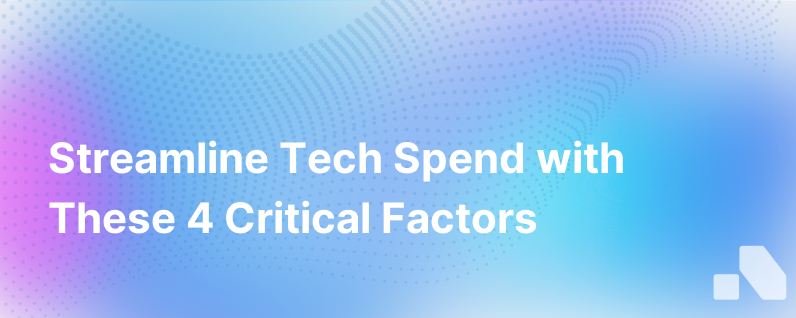4 Key Factors For Consolidating Tech Spend
Published on January 1, 2024 by David Zhang
In today's rapidly evolving business landscape, managing technology expenditures has become a high-wire act for companies of all sizes. With the proliferation of cloud services, software subscriptions, and the shift to a remote or hybrid work environment, tech spend has risen sharply, resulting in the need for efficient consolidation to maintain financial health and gain competitive advantages.
Here we'll explore the four key factors organizations should consider for consolidating their tech spend, which, if done well, can lead to significant cost savings and improved operational efficiency.
Factor 1: Strategic Vision and Business Alignment
Start at the top – with a clear strategic vision. Consolidation isn't merely about cutting costs, it's about aligning your technology investments with the overall business objectives. When considering how and where to consolidate tech spend, it is fundamental to ask how each tech stack or service aligns with your strategic business goals. Seamless integration between business and tech strategies strengthens the company's agility and ability to cope with changes in the market.
Developing a Strategic Vision
- Assess current technology against strategic goals: Evaluate if the tech you're paying for clearly contributes to your strategic objectives, either through increasing efficiency, improving customer experience, or driving innovation.
- Make decisions based on value, not just cost: Often, cheap solutions cost more in the long run due to issues like poor integration, scalability limits, or inadequate support.
- Forecast long-term benefits: Think beyond immediate savings. Consider the future state of the industry and how technology is expected to evolve.
Factor 2: Comprehensive Inventory and Usage Analysis
Understanding what you have is key to understanding what you need. Conducting a thorough inventory of your technology assets and their usage can unearth redundancies, uncover underused or unnecessary tools, and reveal opportunities for consolidation.
Implementing a Thorough Analysis
- Inventory all technology services and subscriptions: Keep an ongoing, updated repository of every technology tool your company pays for, including 'shadow IT' – tools adopted without IT approval.
- Monitor usage statistics: Paying for services that are underused or not used at all is a common way money leeches away. Usage statistics help you decide whether to ditch, downgrade, or consolidate tech services.
- Evaluate alternatives: Compare your current solutions with potential alternatives. In some cases, a more comprehensive tool may be able to handle multiple functions, leading to a reduction in the number of tools required.
Factor 3: Vendor Relationships and Negotiation
Once you have a complete view of your tech spend and how it aligns with your corporate strategy and actual usage, it's time to talk to your vendors. In many instances, companies can leverage their size or strategic importance to vendors to negotiate better terms or bulk services.
Strengthening Vendor Relationships
- Assess the value of each vendor: Do they provide exclusive features or benefits that are critical for your business, or can their services be easily replaced?
- Renegotiate contracts: Approach vendors with data on your usage and requirements, and discuss how you can reshape contracts to suit your needs better.
- Look for bundling options: Vendors may offer discounts for bundled services or a consolidated platform approach that could address multiple needs within your organization.
Factor 4: Integration and Interoperability
The goal of consolidation is not merely to reduce the number of vendors or services but to create a more integrated, streamlined, and efficient technology ecosystem. This factor is about ensuring that the tech tools you decide to keep can work together seamlessly.
Ensuring Seamless Integration
- Audit for interoperability: Check how well your tech stacks interact with each other. Systems that don't communicate well can create silos, inefficiencies, and ultimately, added costs.
- Invest in integration platforms: Sometimes, it's worth investing in platforms designed to integrate disparate systems, especially if the individual pieces provide substantial value on their own.
- Custom development consideration: In some cases, it might be worth developing custom integrations. If you go this route, ensure you have a long-term maintenance and support plan.
Closing Thoughts
Consolidating tech spend is not just about slashing budgets; it's about smartly investing in technology that drives your business forward. It involves aligning tech purchases with strategic objectives, comprehensively understanding your current tech portfolio, fostering relationships with vendors, and prioritizing integration and interoperability.
In the same vein as these key factors, it's crucial to have a platform like Aomni that can assist with such endeavors. Aomni is designed to empower B2B sales with real-time account research, competitive insights, and personalized sales content. While this article isn't meant to be a sales pitch, integrating Aomni into your process can help consolidate your sales tech stack and make such sales tools an operational asset rather than a cost center.
In summary, thoughtful consolidation of tech spend is not just a means to optimize resources but also a strategic business practice that can lead to substantial performance improvement and create a foundation for innovation and growth.